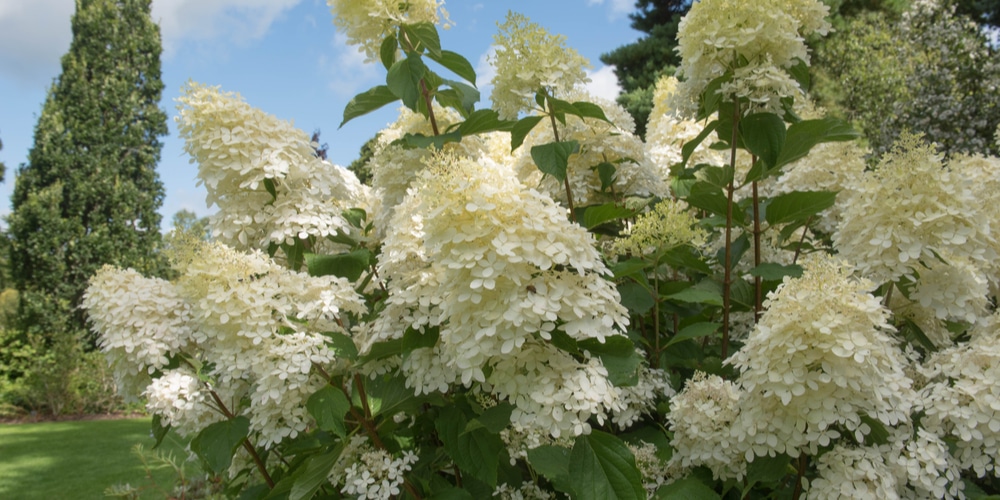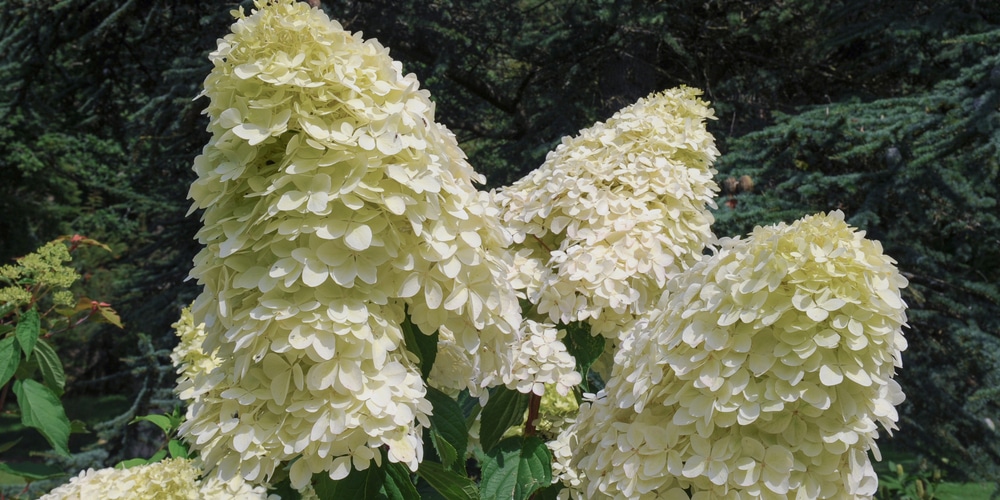Hydrangeas are gorgeous ornamental plants that can add an elegant touch to any landscape. Despite their delicate looks, they are versatile and hardy. Among the various hydrangeas varieties, one of the most eye-catching is, without a doubt, the Phantom Hydrangea.
This plant produces stunning masses of conical-shaped blooms that attract plenty of beneficial insects to your garden. But don’t be fooled by its sophisticated looks: if you know what to give it, this plant will not cause any issues.
But if you want to learn more about growing Phantom Hydrangea in your garden, keep reading. We collected all the information you must know in this essential guide.

| Botanical Name | Hydrangea paniculata “phantom” |
| Common Name | Phantom Hydrangea |
| Plant Type | Perennial |
| Flower Color | The plant produces thick and conical blooms that can measure up to fifteen inches long. The flowers are creamy in the summer and turn pink in the fall. |
| Size When Mature | Up to 6 feet high and 6 feet wide. |
| Bloom Time | Between Early Summer and Fall |
| Sun Requirements | Full to Partial Sun |
| USDA Hardiness Zones | 3-8 |
| Soil PH Range | 5.0 and 7.0 |
| Soil Type | Well-draining, fertile, and moist |
| Water Needs | Medium |
| Native Area | Japan, China, and Korea |
What you Need to Know About Phantom Hydrangea
Phantom Hydrangea is a lovely plant. Its most attractive feature is its thick and conical blooms that can grow up to fifteen inches long. However, the plant’s foliage is unique too and can add texture and volume to your garden.
Under the ideal growing conditions, this hydrangea variety will spread fast. For this reason, many gardeners decide to make it the focal point of their gardens. Alternatively, you can use it as a border or hedge. Phantom Hydrangea will perform well in mass planting: you can deadhead the flowers and use them in dry arrangements.
However, if you have kids or pets running around your garden, you should be careful with hydrangeas. Indeed, these plants are notoriously toxic to cats, dogs, and even horses. All parts of hydrangeas (including the roots and stems) will be poisonous to your animals. So, keep an eye on your hairy friends or consider planting other species if you are too worried they will inevitably munch on your plant’s leaves. Also, its foliage can aggravate skin allergies.
How to Care for Phantom Hydrangea
While caring for a thriving Phantom Hydrangea isn’t anything out of this world, you should learn about the plant’s needs and requirements. Luckily, this plant isn’t too fussy, making it suitable even for beginner gardeners.
Here, we collected all the information you must have on hand when adding Phantom Hydrangea to your garden. Follow our tips, and you’ll be able to enjoy this stunning plant for years!
Light
Place your Phantom Hydrangea in a sunny location. Sunlight will ensure vivid blooms and enhance production. However, if you live in a hot region, you might have to provide your plant with some protection from the afternoon sun rays that might scorch its leaves.
While the plant has no issues tolerating the heat, it requires constant moisture to stay healthy (as you’ll learn in the following section). And exposure to sunlight will bring the best colors.
Water and Soil Needs
One of the best things about Phantom Hydrangea is its versatility. This plant adapts to various soil conditions and doesn’t require a particular pH to produce blooms. However, a well-draining and rich substrate will allow your plant to grow better.
If you live in a warm region, you might have to increase the watering frequency during the hottest summer days. Indeed, your hydrangea requires constant moisture to stay healthy.
Of course, that doesn’t mean overwatering your plant: learn about its needs (by feeling the soil with your fingers) and adjust your watering schedule accordingly. Usually, your plant will need moisture at least once per week.
While the plant might survive short periods of drought, regular watering is essential to its health. To prevent issues, consider adding a thick layer of organic mulch around your plant. It will increase drainage and improve water retention. Additionally, it can make nutrients better available to your hydrangea, which will make it less susceptible to diseases and infections.
Temperature Requirements
You can plant phantom hydrangeas in most US regions. This species is cold-hardy to zone 3 and tolerates the heat. However, it might not be the best plant for areas where summers are hot and dry. So, keep that in mind before adding this plant to your garden.
Fertilizer
Adding extra nutrients to your plant will boost its growth. But don’t overdo it: too much of a good thing can cause issues. Instead, choose a slow-release balanced fertilizer and follow the instructions you find on the label.
Apply the treatment during the growing phase (in the spring) to give your plant an early-season boost. You can also fertilize them a second time in July to enjoy their blooms for longer.
Common Diseases
Most hydrangeas are susceptible to some fungal and viral diseases. However, taking preventive measures (and care of your plant), you shouldn’t worry too much about them. Fungal infections will commonly appear if you overwater your plant.
So, besides placing your plant in an adequate substrate, you must also regulate your watering schedule. And if you notice drooping, yellowing, or reddish lesions on your plant’s leaves, consider reducing the watering frequency.
Also, space your plants adequately to ensure proper airflow. If necessary, prune their branches (use sterile shears to prevent any issues) and remove damaged or dead flowers to prevent the appearance of fungi.
When watering your hydrangeas, do so without wetting the leaves: it will help you prevent the spread of most infections. Keeping your plant healthy will make it less susceptible to attacks from pests. Still, aphids and mites might visit your phantom hydrangea. Taking prompt action will save you plenty of headaches and contain any possible infestation.
Phantom Hydrangea Propagation
The best way to propagate your phantom hydrangea is to take stem cuttings. For best results, start the process in April and May. Pick healthy stems with at least three leaves and place them in a vase of water. The cuttings will root in a couple of weeks. After that, move them into a container with the right potting mix and wait for them to grow!
Related Article: Do Hydrangeas Die in Winter?

